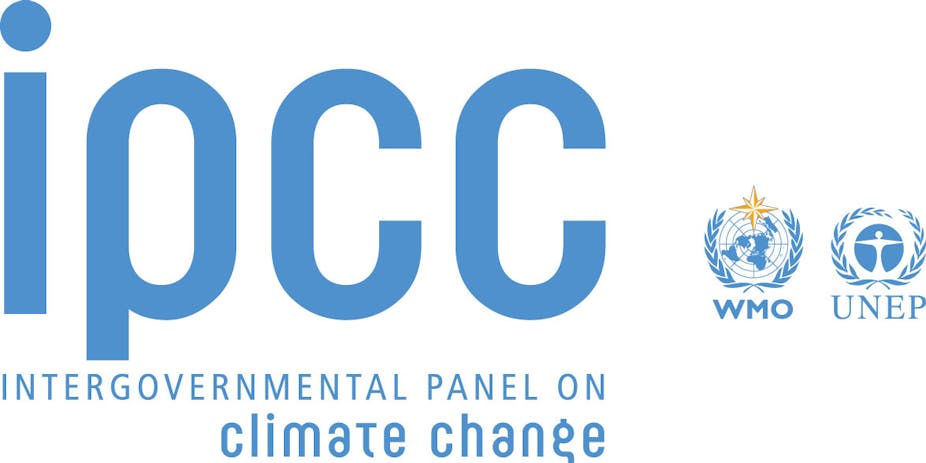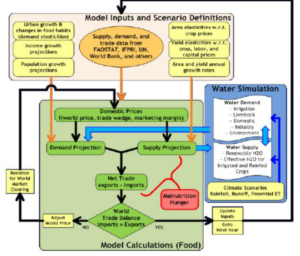What you will find on this page: Final IPCC Synthesis Report 2023; IPCC 6th Assessment indepth Q&A; special report on oceans & cryosphere; Climate change & land IPCC Report; unpacking latest report; Special Report released; Gavin Schmidt responds; typical inane response from our govt; leaked IPCC Special Report;what is the IPCC and what does it do; what does the IPCC have to do with UNFCCC; where is the IPCC up to – AR6; IPCC special reports being written; 5th Assessment reports (AR5); IMPORTANT: To get the most out of IPCC reports you need to keep in mind the following: who signs off on reports; IPCC scenarios – Representative Concentration Pathways (RCPs); understanding how scenario models work (video), RCP’s to be replaced with SSP’s; IPCC language – probability & confidence (they don’t mean what we think they mean); key messages from current AR5 reports. Also refer to: “Global Action/Inaction” page and “Fairyland of 2 degrees” page
Q&A: IPCC wraps up its most in-depth assessment of climate change
23 March 2023, Carbon Brief: The final part of the world’s most comprehensive assessment of climate change – which details the “unequivocal” role of humans, its impacts on “every region” of the world and what must be done to solve it – has now been published in full by the UN’s Intergovernmental Panel on Climate Change (IPCC). The synthesis report is the last in the IPCC’s sixth assessment cycle, which has involved 700 scientists in 91 countries. Overall, the full cycle of reports has taken eight years to complete. The report sets out in the clearest and most evidenced detail yet how humans are responsible for the 1.1C of temperature rise seen since the start of the industrial era. It also shows how the impacts of this level of warming are already deadly and disproportionately heaped upon the world’s most vulnerable people.
The report notes that policies in place by the end of 2021 – the cut-off date for evidence cited in the assessment – would likely see temperatures exceed 1.5C this century and reach around 3.2C by 2100. In many parts of the world, humans and ecosystems will be unable to adapt to this amount of warming, it says. And the losses and damages will “escalate with every increment” of global temperature rise. But it also lays out how governments can still take action to avoid the worst of climate change, with the rest of this decade being crucial for deciding impacts for the rest of the century. The report says: “There is a rapidly closing window of opportunity to secure a liveable and sustainable future for all…The choices and actions implemented in this decade will have impacts now and for thousands of years.” For more detail access this link.
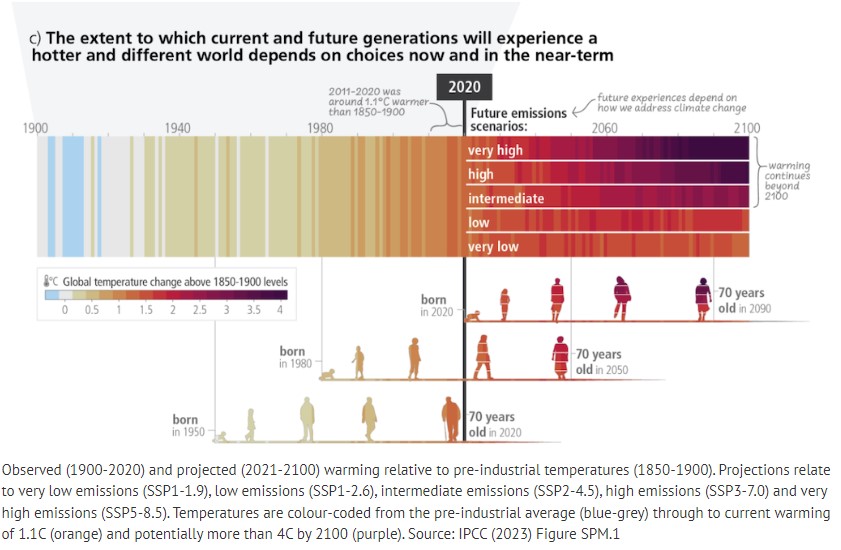
LINK TO FULL REPORT: SYNTHESIS REPORT OF THE IPCC SIXTH ASSESSMENT REPORT (AR6) Summary for Policymakers
In-depth Q&A: The IPCC’s sixth assessment on how climate change impacts the world
28 February 2022, Carbon Brief: The threat that climate change poses to human well-being and the health of the planet is “unequivocal”, says the latest report from the United Nations’ Intergovernmental Panel on Climate Change (IPCC).
The expansive review – which forms the second part of the IPCC’s sixth assessment report (AR6) – warns that any further delay in global action to slow climate change and adapt to its impacts “will miss a brief and rapidly closing window of opportunity to secure a liveable and sustainable future for all”. The report follows the publication of the first part of AR6, released in August last year, which set out how and why the Earth’s climate is changing. Over the past two weeks, government delegations have been meeting during a two-week online approval session to agree on the high-level “summary for policymakers” section. The final report is published against the backdrop of Russia’s invasion of Ukraine, which forced some members of the Ukrainian delegation to pull out of the approval session and hide in bomb shelters. One member commented that “we will not surrender in Ukraine and we hope the world will not surrender in building a climate resilient future”. Focusing on the impacts of global warming and efforts to adapt to it, the report lays bare how climate change is being felt across the planet. Among the findings, the report concludes that:
- Climate change has already caused “substantial damages and increasingly irreversible losses, in terrestrial, freshwater and coastal and open ocean marine ecosystems”.
- It is likely that the proportion of all terrestrial and freshwater species “at very high risk of extinction will reach 9% (maximum 14%) at 1.5C”. This rises to 10% (18%) at 2C and 12% (29%) at 3C.
- Approximately 3.3 to 3.6 billion people “live in contexts that are highly vulnerable to climate change”.
- Where climate change impacts intersect with areas of high vulnerability, it is “contributing to humanitarian crises” and “increasingly driving displacement in all regions, with small island states disproportionately affected”.
- Increasing weather and climate extreme events “have exposed millions of people to acute food insecurity and reduced water security”, with the most significant impacts seen in parts of Africa, Asia, Central and South America, small islands and the Arctic.
- Approximately 50-75% of the global population could be exposed to periods of “life-threatening climatic conditions” due to extreme heat and humidity by 2100.
- Climate change “will increasingly put pressure on food production and access, especially in vulnerable regions, undermining food security and nutrition”.
- Climate change and extreme weather events “will significantly increase ill health and premature deaths from the near- to long-term”. READ MORE HERE
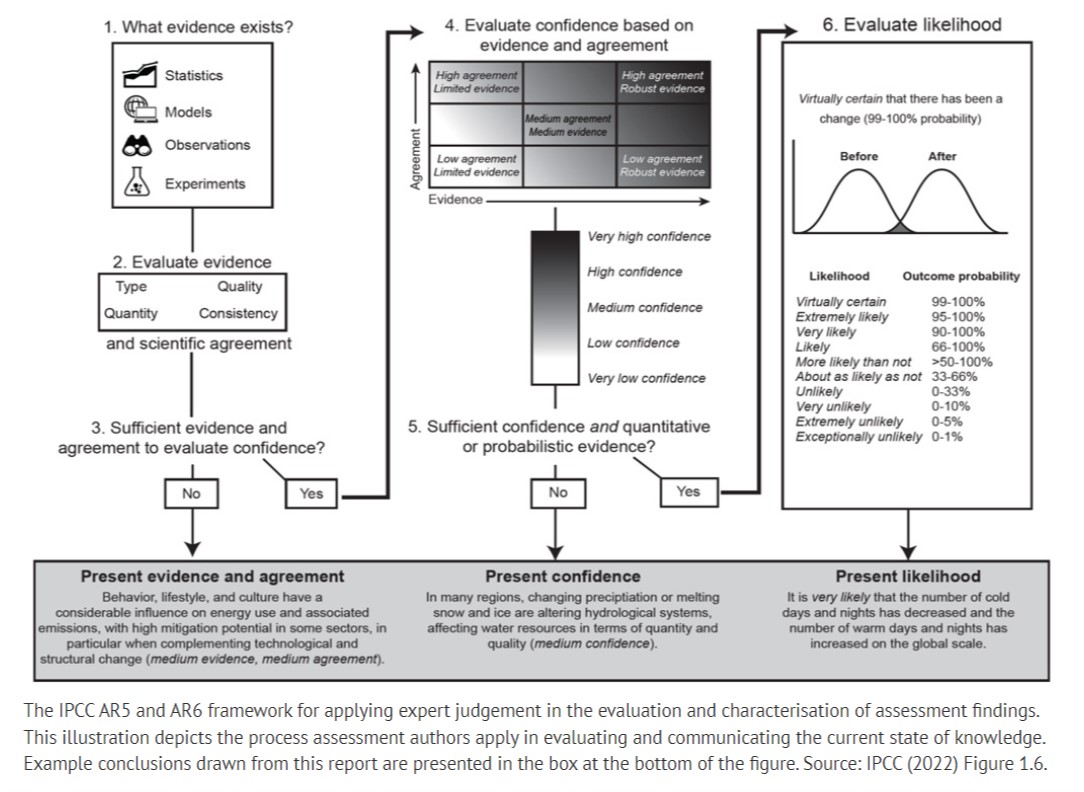
Scientists react: What are the key new insights from the IPCC’s WG2 report?
1 March 2022, Carbon Brief: A new report out this week by the UN’s Intergovernmental Panel on Climate Change (IPCC) details how climate change has “caused widespread adverse impacts and related losses and damages to nature and people”.
It forms the second part of the IPCC’s sixth assessment report (AR6) and follows the first element that was published in August 2021. While the first part focused on the “physical science basis” of the Earth’s changing climate, the second report – by the IPCC’s Working Group II (WG2) – presents the latest evidence on the impacts of climate change and the ways of adapting to them. It details how the “rise in weather and climate extremes has led to some irreversible impacts as natural and human systems are pushed beyond their ability to adapt”. The full report was published on 28 February following a two-week online approval session where government delegates met to agree line-by-line the high-level summary for policymakers (SPM). In this article, Carbon Brief has asked a mix of researchers who contributed to the new report what they think are its most important insights. Read more here
The IPCC approved and accepted Special Report on the Ocean and Cryosphere in a Changing Climate at its 51st Session held on 20 – 23 September 2019. The approved Summary for Policymakers (SPM) was presented at a press conference on 25 September 2019.
For the IPCC Special Report on the Ocean and Cryosphere in a Changing Climate, more than 100 scientists from more than 30 countries assessed the latest scientific knowledge about the physical science basis and impacts of climate change on ocean, coastal, polar and mountain ecosystems, and the human communities that depend on them. Their vulnerabilities as well as adaptation capacities were also evaluated. Options for achieving climate-resilient development pathways were presented as well. SROCC follows the Special Report on Climate Change and Land (SRCCL) released in August 2019 and the Special Report on Global Warming of 1.5ºC released in October 2018. Access the report here
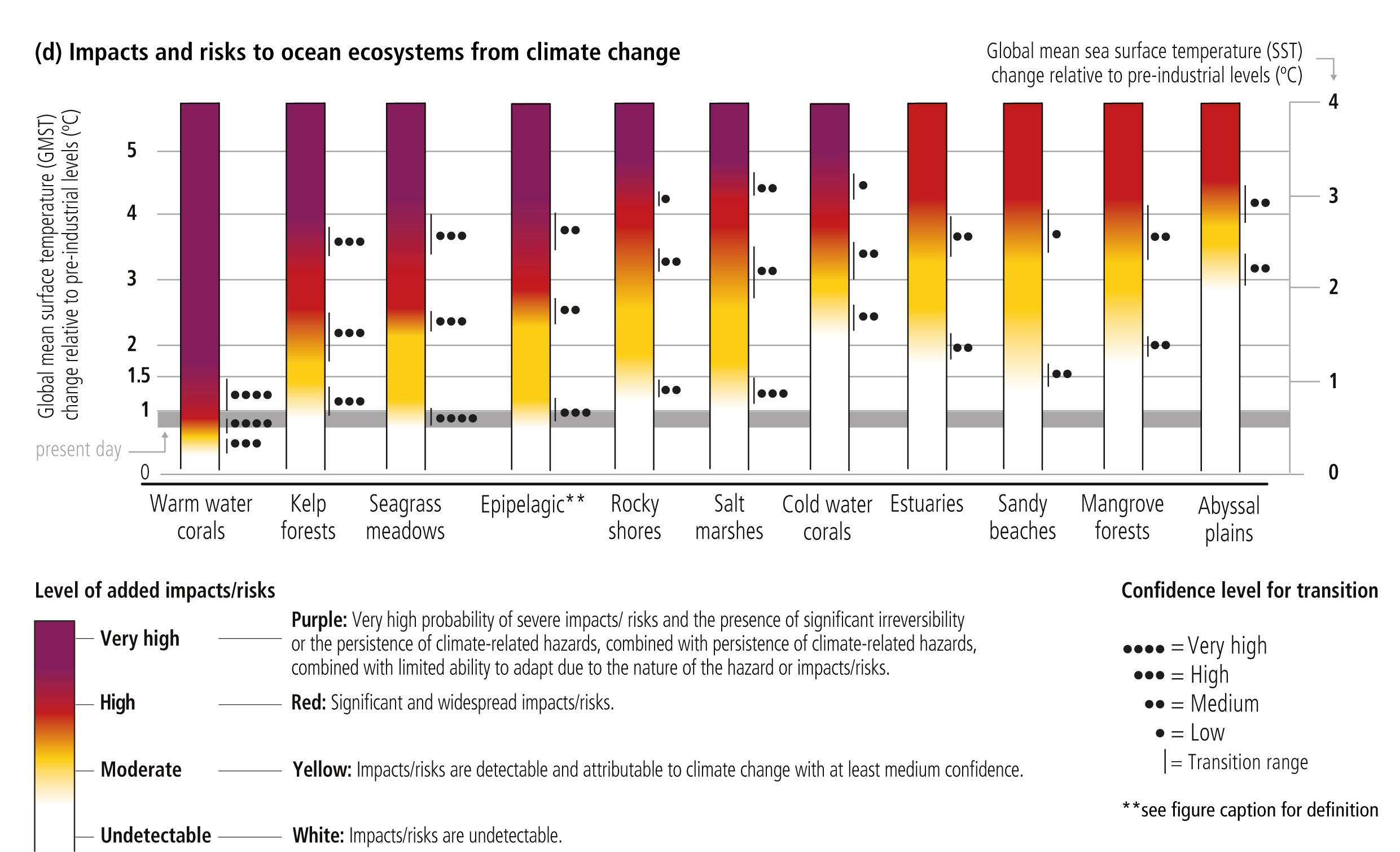
Climate Change and Land – Latest IPCC report
8 August 2019: An IPCC special report on climate change, desertification, land degradation, sustainable land management, food security, and greenhouse gas fluxes in terrestrial ecosystems. The IPCC approved and accepted Climate Change and Land: an IPCC special report on climate change, desertification, land degradation, sustainable land management, food security, and greenhouse gas fluxes in terrestrial ecosystems at its 50th Session held on 2 – 7 August 2019. The approved Summary for Policymakers (SPM) was presented at a press conference on 8 August 2019. Download the SPM here
- Press Release: Land is a Critical Resource, IPCC report says ( Arabic, Chinese, French, Russian, Spanish)
- Headline Statements
- Presentation (6.5 MB)
- Factsheet
- Recording of press conference on Facebook and UNTV
- Information about press conference speakers
- List of authors
8 August 2019, Carbon Brief: In this detailed Q&A, Carbon Brief unpacks what the IPCC report says about how climate change affects the land and vice versa, as well as other key topics such as food security, negative emissions and how to tackle the overlapping challenges associated with how humans use the land. Access more here
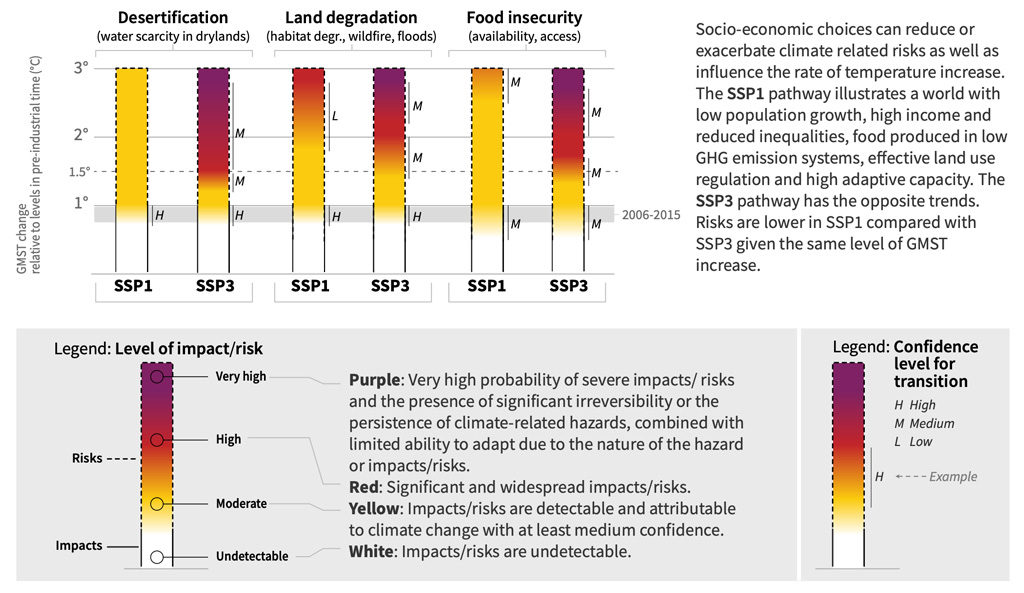
Figure showing how different socioeconomic pathways (SSP1 and SSP3) will affect climate-related risks. The colours represent levels of impact/risk, with purple meaning very high risks and the presence of “significant irreversibility”, climate-related hazards and limited ability to adapt, and white indicating no impacts that are detectable and attributable to climate change. Letters represent the level of confidence in the findings (with “L” representing low, “M” representing medium and “H” representing high). Source: IPCC land report, Figure SPM. 2b.
Well, the Special Report has been released, what does it mean
8 October 2018, Carbon Brief, Earlier today in South Korea, the Intergovernmental Panel on Climate Change (IPCC) published its long-awaited special report on 1.5C (Link to report). The IPCC is a body of scientists and economists – first convened by the United Nations (UN) in 1988 – which periodically produces summaries of the “scientific basis of climate change, its impacts and future risks, and options for adaptation and mitigation”. The reports are produced, in the first instance, to inform the world’s policymakers. In this detailed Q&A, Carbon Brief explains why the IPCC was asked to produce a report focused on 1.5C of global warming, what the report says and what the reaction has been…Click on different sections below or access full article here
- Why did the IPCC produce this special report?
- How far away is 1.5C of warming?
- How do the impacts of climate change compare between 1.5C and 2C?
- How quickly do emissions need to fall to meet the 1.5C limit?
- What would it take to limit warming to 1.5C?
- What does the report say about the remaining carbon budget for 1.5C?
- What role will ‘negative emissions’ play in limiting warming to 1.5C?
Gavin Schmidt, NASA Goddard Institute, responds to report
Gavin’s response to the question – Can we avoid going through 1.5ºC?IPCC has to use a few circumlocutions to avoid giving a direct answer to this question (for reasonable and understandable reasons). I’m not quite so constrained… There are many issues related to the feasibility question of which physical climate-related issues are only one. The basic issue is that the effort to reduce emissions sufficiently to never get past 1.5ºC would require a global effort to decarbonize starting immediately that would dwarf current efforts or pledges. This seems unlikely (IMO). There are a few ‘get-out-of-jail’ cards that are considered. First, we can overshoot 1.5ºC, and then come back down after heroic efforts to reduce CO2 levels in the atmosphere though so-called ‘negative emissions’. This makes the immediate task less daunting, but at the expense of relying on global scale efforts with carbon sequestration, or BECCS, or direct air capture, which are extremely speculative. Second, we could start direct geo-engineering efforts to reduce temperatures and (most optimistically) buy time for carbon emissions to come down a little more slowly. Both of these scenarios come with dramatic and underexplored geo-political consequences (are there any stable governance regimes for geo-engineering? is there sufficient land for large scale BECCS?), as well as substantial moral hazard. So my answer is… no. I get that there is reluctance to say this publically – it sounds as if one is complicit in the impacts that will occur above 1.5ºC, but it seems to me that tractable challenges are more motivating than impossible (or extremely unfeasible) ones – I would be happy to be proven wrong on this though Read on for more of his response or to read his full response, access here.
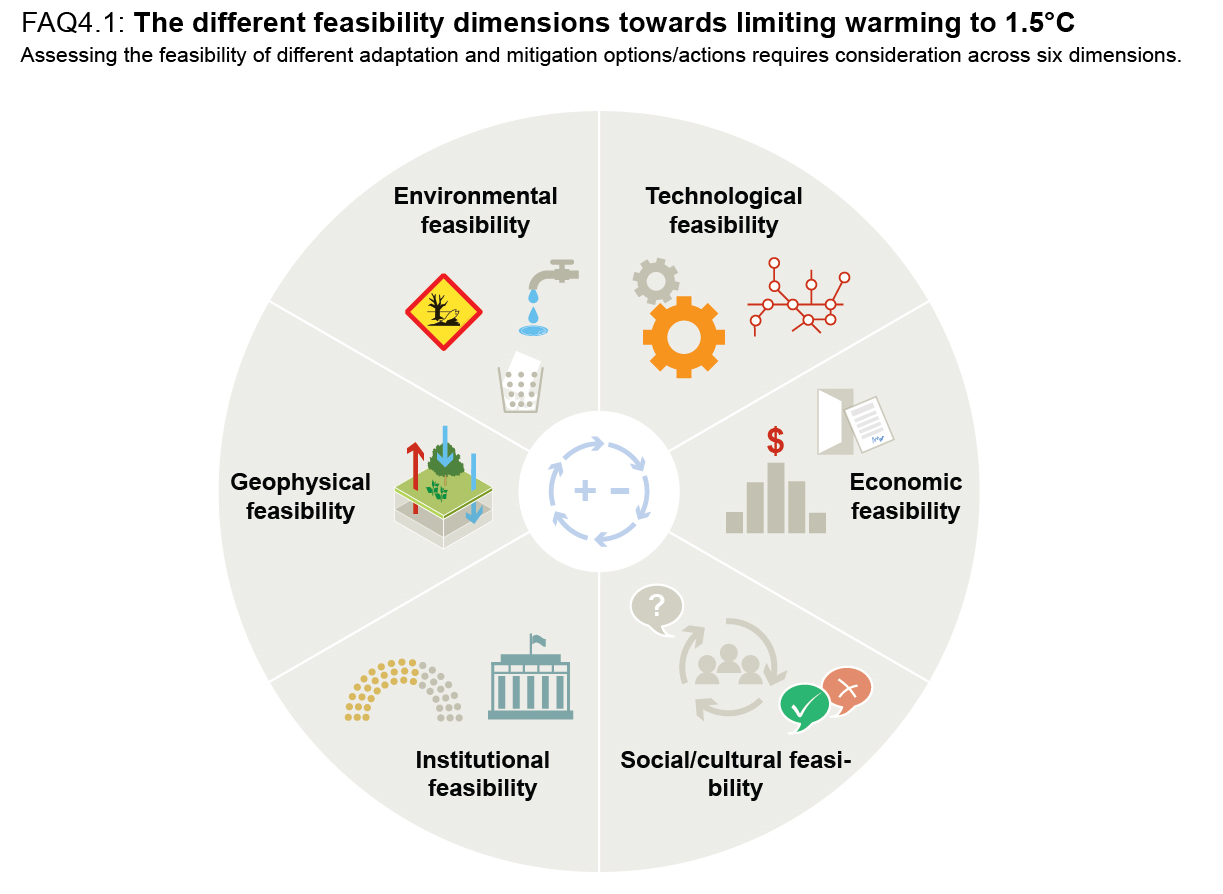
Thoughts: It’s well worth reading the SPM and FAQs before confidently pronouncing on the utility or impact of this report. The FAQs include the following questions:
- FAQ 1.1: Why are we talking about 1.5°C?
- FAQ 1.2: How close are we to 1.5°C?
- FAQ 2.1: What kind of pathways limit warming to 1.5°C and are we on track?
- FAQ 2.2: What do energy supply and demand have to do with limiting warming to 1.5°C?
- FAQ 3.1: What are the impacts of 1.5°C and 2°C of warming?
- FAQ 4.1: What transitions could enable limiting global warming to 1.5°C?
- FAQ 4.2: What are Carbon Dioxide Removal and negative emissions?
- FAQ 4.3: Why is adaptation important in a 1.5°C warmer world?
- FAQ 5.1: What are the connections between sustainable development and limiting global warming to 1.5°C?
- FAQ 5.2: What are the pathways to achieving poverty reduction and reducing inequalities while reaching the 1.5°C world?
First thing to remember is that this special report was commissioned from the UNFCCC on the back of the Paris Accord (which is not the process for main IPCC reports). Secondly, the IPCC is constrained to only assess published literature or otherwise publically available data. This means that if no groups have studied a question, there isn’t much to assess. Sometimes the gaps are apparent even in the scoping of the reports which can encourage people to focus on them at an early stage and have publications ready in time for the final report, but one of the main impacts of any of these reports is to influence research directions going forward. Read more here
And how does our govt respond? Coalition’s breathtakingly stupid response to IPCC climate report
9 October 2018, Renew Economy, It wasn’t too hard to predict what the Coalition government’s responses to the UN Intergovernmental Panel on Climate Change report would be – you just needed to know where they would be making them. Prime minister Scott Morrison chose two different media forums to espouse his views – that of far Right shock-jock Alan Jones on Radio 2GB, and Sky News, where the lunar right have been gearing up for this event for the past week. As ABC’s Media Watch host Paul Barry noted of the Sky News “after dark” coverage on Monday: It’s either irresponsible or “bat-shit” crazy. You could categorise the Coalition government’s response along the same lines. Morrison’s first response, as we reported on Monday, was to promise that Australia would be spending no money on climate change conferences and “all that nonsense.” He doesn’t dare pull Australia out of the Paris treaty, but he has no intention of doing anything while it’s there. Pretty much Australia’s standard response to international efforts for the last few decades. “We are not held to any of the (IPCC recommendations), and nor are we bound by them,” Morrison insisted. In short, Morrison was backing miners over scientists, as the Sydney Morning Herald headlined. In the fantasy world of the Coalition, according to deputy prime minister Michael McCormack, Australia can have its cake and it eat too: He says Australia can keep on burning coal for decades, and encourage others to do so, and still have a tourism industry on the Great Barrier Reef. McCormack says Australia will not be dictated to by “some sort of report.” Some sort of report? If you wish to bother, access full article here
Purpose of IPCC is to REPORT: latest leak on draft Special Report on 1.5C
27 June 2018, Climate Homes News, Leaked final government draft of UN 1.5C climate report – annotated. A draft summary of the most important climate science report of 2018, published here annotated with changes from the previous version. What is this document? This is the second draft of the summary for policymakers of the special report on 1.5C. It has been compiled by climate scientists from around the world. A draft, which was published by Climate Home News in February, was circulated to the scientific community for review earlier this year. The latest version, dated 4 June, has been sent to governments for comments on the ‘summary for policymakers’ (see below). The review runs until 29 July. What is a ‘summary for policymakers’? The full report, known as the IPCC Special Report on Global Warming of 1.5C, will run to hundreds of pages of scientific data and findings. This is shortened set of conclusions and findings drawn from the larger report designed to provide information in a useable way for decision makers. Throughout the text you’ll see references to chapters in the larger report in curved brackets: eg. {2.3,2.5.3}. Read More here
While it may be true that global warming threatens economic growth, it is far more salient to say that economic growth threatens us with global warming.
17 June 2018, Resilience, Leaked U.N. climate change report shows inverted thinking on growth. The Reuters news service managed a genuine journalistic coup by getting an advance copy of a U.N. climate change report not due out until October. Given what the report says—it’s dire—and the fact that the climate isn’t going to stop changing while the report gets reviewed, somebody decided to get the ball rolling. Reuters has so far chosen not to make the entire draft available. But from its reporting we can see already the contradictory thinking that remains a barrier to facing up to climate change, to wit: Global warming is on course to exceed the most stringent goal set in the Paris agreement by around 2040, threatening economic growth… This kind of thinking is so obviously inverted, and yet the inversion is entirely invisible to most people. While it may be true that global warming threatens economic growth, it is far more salient to say that economic growth threatens us with global warming. There is a partial but perhaps unconscious recognition of this fact in the following from the Reuters story: The report outlines one new scenario to stay below 1.5°C, for instance, in which technological innovations and changes in lifestyles could mean sharply lower energy demand by 2050 even with rising economic growth. Generally speaking, changes in lifestyle on a scale necessary to bring about “sharply lower energy demand” would mean an end to economic growth. What is supposed to keep growth going in this scenario is, of course, technological innovation. While it is true that innovation can make energy production less carbon intensive, what it can’t do is prevent people from using more energy, especially if supply continues to grow and the price remains affordable. Energy efficiency generally makes energy cheaper even as the person being efficient saves money. Without caps on the absolute amount of energy we can all use, energy efficiency just leads to higher energy consumption. This is called the Jevons Paradox. (check it out) Read More here
What is it and what does it do?
The Intergovernmental Panel on Climate Change (IPCC) is an intergovernmental body whose governing Panel is made up of government members representing 195 countries. But the Assessment Reports the IPCC produces are drawn up by a very large, global group of scientists and experts who contribute their time in drafting and revising and reviewing.
It was established by the United Nations Environment Programme (UNEP) and the World Meteorological Organization (WMO) in 1988 to provide the world with a clear scientific view on the current state of knowledge in climate change and its potential environmental and socio-economic impacts. It reviews and assesses the most recent scientific, technical and socio-economic information produced worldwide relevant to the understanding of climate change.These reports bring together the best of the recently published scientific and technical literature. It does not conduct any research nor does it monitor climate related data or parameters. It is intended to be “policy relevant but not policy prescriptive”.
NOTE: The IPCC is however, not ‘owned’ by the research community. It is owned by the governments of the world (the ‘Intergovernmental’ part of the name) and the Summary for Policymakers in particular is trawled over word by word by those governments. Whatever the research community writes in IPCC report drafts, it can be changed by the governments. In practice this is only likely to happen in the Summary for Policymakers and through this the Executive Summaries of the chapters, rather than the chapter text itself. Also as new research is continually evolving, the long process of developing the reports ensures that it can be years out of date at time of approval. This is then compounded by the 7 years between reports.
The IPCC is organised into three Working Groups and a Task Force. Working Group I deals with “The Physical Science Basis of Climate Change”, Working Group II deals with “Climate Change Impacts, Adaptation and Vulnerability”, and Working Group III deals with “Mitigation of Climate Change”. The Task Force refines the methodology for the calculation and reporting of national greenhouse gas emissions and reductions. All these groups have two co-chairs, one from a developed country and one from a developing country. The final reports from these working groups are collectively known as an “Assessment Report”. The IPCC have already produced 5 Assessment Reports with the 6th Assessment Report (AR6) to be completed 2020-21.
Draft, review, draft, review – you did ask!
Governments and other bodies nominate potential IPCC authors who are experts in their field, and are selected also to try and produce a geographical and gender balance. Groups of around 10-20 experts prepare individual chapters covering their area of expertise. The first step in bringing these chapters together to form an assessment report starts when authors and co-chairs meet to develop a Zero Order Draft, which will take about three months, perhaps involving additions from invited Contributing Authors. The draft is then distributed to a small number of reviewers, who for each chapter provide feedback on how well the structure and proposed content works. The next step is to prepare a First Order Draft, which is distributed for expert review. At this stage anyone can self-nominate as an “expert”, if they can justify their credentials and expertise, and on condition that they agree to adhere to the rule of confidentiality, so there are no leaks of early drafts. Several months are allowed for expert comments, which are individually identified and linked to the expert offering them. The First Order Draft of Working Group I for forthcoming AR5 report for example received 21,400 comments from 659 experts. The authors respond to each of the comments, and these responses are also tagged and recorded. A Second Order Draft is prepared based on review comments, including a Summary for Policymakers (SPM) that summarises the most important conclusions. This draft is returned to the experts for another review, and also to government panel members for their comments. The AR5’s Second Order Draft for Working Group I received 31,422 comments from about 800 experts and 26 governments.
Tying things together
At this stage we approach the cut-off date for scientific literature that can be cited in the report, usually about six months before the final Plenary meeting where the document is approved. Authors meet again to consider the comments on the Second Order Draft, and to start preparing the Final Draft. This, once ready, is passed to government members for a final review. The final author meeting is held immediately prior to a Working Group Plenary and responds to government comments on the final draft. The revised draft is then taken into the Working Group Plenary for discussion and, ultimately, approval. The Summary for Policymakers is discussed and approved line-by-line and, if necessary, word-by-word. Lead Authors explain and defend their chapter’s contributions. If there is a dispute, a smaller group may be established to refine the language. The role of the Plenary is to ensure what ends up in the document governments will read is appropriate and clear, but still accurately reflects the science. The Working Group Plenary will then accept the report made up of the chapters prepared and reviewed by authors and approve the final Summary for Policymakers. This usually happens in the early hours of the morning after the final of four days of tough negotiations between all parties, and generally only a few hours before a scheduled launch press conference.
What does the IPCC have to do with UNFCCC, aka global climate change talks and agreements??
For more than 20 years the IPCC process has managed to assimilate the rapidly expanding scientific literature about climate change, and summarise it for those that need to know. e.g. UNFCCC. The interest shown in the IPCC reports illustrates how important these Assessments have been in trying to keep track of and understand what the science tells us. And the unique if long winded IPCC process – open, transparent, and involving as many relevant parties as possible – is why its work is respected.
The 43rd Session of the IPCC held in April 2016 agreed that the AR6 Synthesis Report would be finalized in 2022 in time for the first UNFCCC global stocktake when countries will review progress towards their goal of keeping global warming to well below 2 °C while pursuing efforts to limit it to 1.5 °C.
The IPCC is now preparing the 6th Assessment Reports (AR6):
- Working Group 1 (assesses the physical scientific aspects of the climate system and climate change. The main topics assessed by WG I include: changes in greenhouse gases and aerosols in the atmosphere; observed changes in air, land and ocean temperatures, rainfall, glaciers and ice sheets, oceans and sea level; historical and paleoclimatic perspective on climate change; biogeochemistry, carbon cycle, gases and aerosols; satellite data and other data; climate models; climate projections, causes and attribution of climate change. ): April 2021
- Working Group 2 (assesses the vulnerability of socio-economic and natural systems to climate change, negative and positive consequences of climate change, and options for adapting to it. It also takes into consideration the inter-relationship between vulnerability, adaptation and sustainable development): October 2021
- Working Group 3 (assesses options for mitigating climate change through limiting or preventing greenhouse gas emissions and enhancing activities that remove them from the atmosphere. The main economic sectors are taken into account, both in a near-term and in a long-term perspective): July 2021
- FINAL IPCC Synthesis Report – AR6 to be approved 4-10 April 2022. For more information access here
The IPCC is also producing a number of Special Reports
Special Report on Global Warming of 1.5 °C (SR15) Following the decision of the panel at its 43rd Session to accept the invitation from the UNFCCC, at its 44th Session, the Panel approved the outline of Global Warming of 1.5 °C, an IPCC special report on the impacts of global warming of 1.5 °C above pre-industrial levels and related global greenhouse gas emission pathways, in the context of strengthening the global response to the threat of climate change, sustainable development, and efforts to eradicate poverty. The report will be finalized in October 2018
Special Report on the Ocean and Cryosphere in a Changing Climate (SROCC). At its 43rd Session (Nairobi, Kenya, 11 – 13 April 2016), the IPCC decided to prepare a special report on climate change and the oceans and the cryosphere. During its 45th Session (Guadalajara, Mexico, 28 – 31 March 2017), the Panel approved the outline of the Special Report on the Ocean and Cryosphere in a Changing Climate to be finalized in September 2019.
Special Report on Climate Change and Land (SRCCL) At its 43rd Session (Nairobi, Kenya, 11 – 13 April 2016), the IPCC decided to prepare a special report on climate change, desertification, land degradation, sustainable land management, food security, and greenhouse gas fluxes in terrestrial ecosystems. At its 45th Session (Guadalajara, Mexico, 28 – 31 March 2017), the Panel approved the outline of Climate Change and Land: an IPCC special report on climate change, desertification, land degradation, sustainable land management, food security, and greenhouse gas fluxes in terrestrial ecosystems. The report will be finalized in September 2019.
Current 5th Assessment Reports (AR5)
To access details concerning the current 5th Assessment reports (AR5) go here
The decision to prepare a Fifth Assessment Report (AR5) was taken by the members of the IPCC at its 28th Session (09-10 April 2008, Budapest, Hungary). The final reports were published throughout 2013/14.
The IPCC has delivered 5 reports since 1990.
There are also a number of special and technical reports in between the previous Assessment Reports. Access the above link for details (go to end of page in link)
IMPORTANT: To get the most out of IPCC reports you need to keep in mind the following…
1. Who signs off on the final reports
Each Summary for Policymakers is written by a team of scientists and reviewed by experts and government representatives as part of the second draft of the Working Group report. Government representatives then meet and negotiate an agreement of the final wording line by line. This process is intended to result in language that can be understood by policymakers and to increase the chance that governments will ‘buy in’ to the key conclusions of the assessment.
This however raises concerns that reinterpretation of the assessment’s findings, suggested in the final Plenary might be politically motivated. As these negotiations can also take several days and commonly end in an all night session it can give the impression that individuals with the most endurance or the countries that have large delegations can end up having the most influence on the report. Source: Evaluation of IPCC’s Assessment Process.
A place where the non-scientific person can flounder in ignorance and boredom. But knowing the basics is essential in understanding what the science is saying. The current AR5 bases its findings on a new set of scenarios that replace the Special Report on Emissions Scenarios (SRES) standards employed in the two previous reports. The new scenarios are called Representative Concentration Pathways (RCPs). There are four pathways: RCP8.5, RCP6, RCP4.5 and RCP2.6 – the last is also referred to as RCP3-PD. (The numbers refer to forcings for each RCP; PD stands for ‘Peak and Decline‘).
The IPCC Scenario Process for AR5 states: “The goal of working with scenarios is not to predict the future but to better understand uncertainties and alternative futures, in order to consider how robust different decisions or options may be under a wide range of possible futures”. (click on image to enlarge)
Representative Concentration Pathways (RCPs) Primary Characteristics
RCP 8.5 Increasing greenhouse gas emissions over time, representative of scenarios in the literature that lead to high greenhouse gas concentration levels (Riahi et al. 2007)
RCP 6 Stabilisation scenario in which total radiative forcing is stabilised shortly after 2100, without overshoot, by the application of a range of technologies and strategies for reducing greenhouse gas emissions (Fujino et al. 2006; Hijioka et al. 2008).
RCP 4.5 Stabilisation scenario in which total radiative forcing is stabilised shortly after 2100, without overshooting the long-run radiative forcing target level (Clarke et al. 2007; Smith and Wigley 2006; Wise et al. 2009).
RCP 2.6 Representative of scenarios in the literature that lead to very low greenhouse gas concentration levels; It is a “peak-and-decline” scenario; In order to reach the specific radiative forcing levels, greenhouse gas emissions (and indirectly emissions of air pollutants) are reduced substantially, over time. (van Vuuren et.al. 2011)
If you are now totally confused either go to the following links for more detail: The Beginners Guide to Representative Concentration Pathways; Scenario Process for AR5. Note that the RCP’s will be soon superceded by the SSP’s – see below. Also REMEMBER when you are reading any scientific reports using these scenarios the world is currently tracking at the highest emission rate scenario RCP 8.5. They are also now (2018) needing much updating to align with current observational data. Another important point is that models are all based on a range of assumptions and these may not necessarily correspond to the real world.
Understanding how scenarios work
Over the past few years, an international team of climate scientists, economists and energy systems modellers have built a range of new “pathways” that examine how global society, demographics and economics might change over the next century. They are collectively known as the “Shared Socioeconomic Pathways” (SSPs).
These SSPs are now being used as important inputs for the latest climate models, feeding into the Intergovernmental Panel on Climate Change (IPCC) sixth assessment report due to be published in 2020-21. They are also being used to explore how societal choices will affect greenhouse gas emissions and, therefore, how the climate goals of the Paris Agreement could be met. These scenarios are based on narratives.
These narratives describe alternative pathways for future society. They present baselines of how things would look in the absence of climate policy, and allow researchers to examine barriers and opportunities for climate mitigation and adaptation in each possible future world when combined with mitigation targets.
SSP1 and SSP5 envision relatively optimistic trends for human development, with “substantial investments in education and health, rapid economic growth, and well-functioning institutions”. They differ in that SSP5 assumes this will be driven by an energy-intensive, fossil fuel-based economy, while in SSP1 there is an increasing shift toward sustainable practices.
SSP3 and SSP4 are more pessimistic in their future economic and social development, with little investment in education or health in poorer countries coupled with a fast-growing population and increasing inequalities.
SSP2 represents a “middle of the road” scenario historical patterns of development are continued throughout the 21st century.
The SSPs were designed to reflect worlds in which mitigation and adaptation challenges vary from low to very high. While the baseline SSP scenarios assume an absence of climate policy, researchers also wanted to look at how the underlying socioeconomic conditions would affect the implementation of climate policy. For more details go here.
How more complicated can it get!!
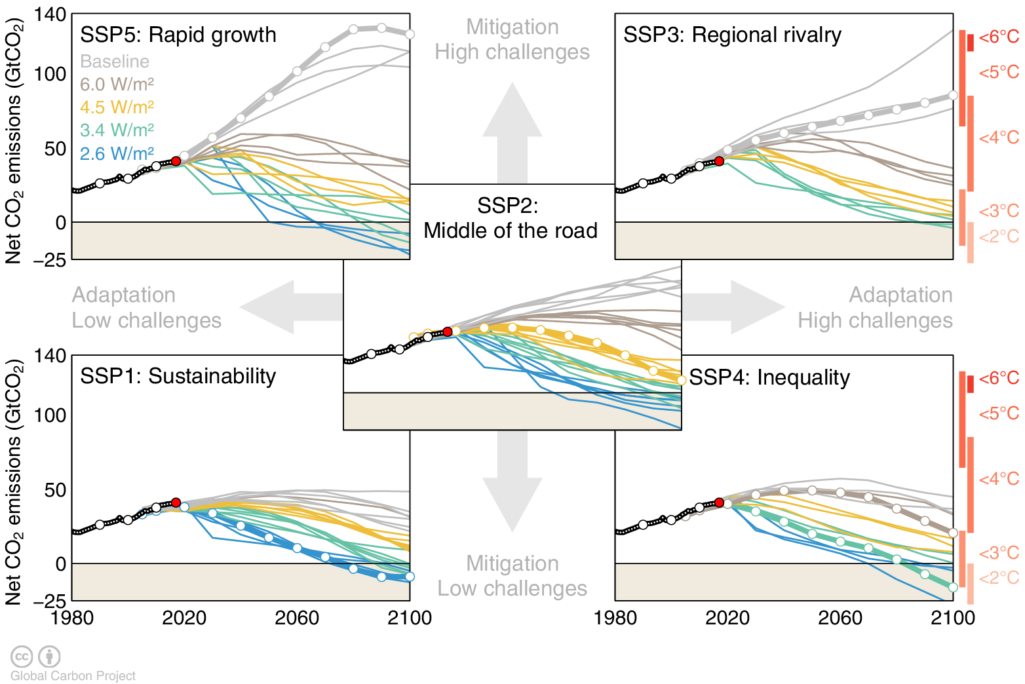
3. The language – IPCC Likelihood Probability Scale (Likelihood of the Outcome) and Confidence Levels
When the IPCC scientists use the terms ‘confidence’ and ‘likelihood,’ each term has a different and very specific meaning relating to levels of certainty.
When scientists mention ‘confidence’, they are referring to the degree of confidence in being correct. In the case of the IPCC where scientists are analysing global climate, issues such as lack of observational data in certain regions, such as Africa, will affect scientists’ confidence in their findings. When scientists mention ‘likelihood’ they are referring to the probability of an event or outcome occurring.
If an event is given a very high confidence level, there is a combination of high agreement and robust evidence that it will occur.
| Term | Likelihood of the outcome |
| Virtually certain | >99% probability |
| Extremely likely | >95% probability |
| Very likely | >90% probability |
| Likely | >66% probability |
| More likely than not | >50% probability |
| About as likely as not | 33 to 66% probability |
| Unlikely | <33% probability |
| Extremely unlikely | <5% probability |
| Exceptionally unlikely | <1% probability |
If an event is virtually certain, there is a greater than 99% probability that it will occur.
REMEMBER: When you read IPCC reports and see these terms have a think about the probability rating of ordinary activities that we all normally insure against:
- House burning down: 1% probability
- Involved in serious car accident in our lifetime: 30% probability
- And the days we buy a lottery ticket, just in case…: 0.026084% probability of winning (less than 3/100th of a percent)
You would think it’s a no brainer to put into place some proactive risk management when faced with the odds above.
Sources: Confidence and Likelihood in the IPCC Fifth Assessment Report Fact Sheet, Australian Govt, Dept of Environment
IPCC Cross-Working Group Meeting on Consistent Treatment of Uncertainties
Key messages Fifth Assessment Report (AR5)
Greenhouse gas concentrations not seen for 800,000 years
The atmospheric concentrations of carbon dioxide, methane, and nitrous oxide have increased to levels unprecedented in at least the last 800,000 years. Carbon dioxide concentrations have increased by 40% since pre-industrial times, primarily from fossil fuel emissions and secondarily from net land use change emissions. The ocean has absorbed about 30% of the emitted anthropogenic carbon dioxide, causing ocean acidification. Limiting climate change will require substantial and sustained reductions of greenhouse gas emissions.
Human influence on the climate system is clear
This is evident from the increasing greenhouse gas concentrations in the atmosphere, positive radiative forcing, observed warming, and understanding of the climate system. It is extremely likely (95-100% probability) that human influence has been the dominant cause of the observed warming since the mid-20th century.
Warming will continue
Continued emissions of greenhouse gases will cause further warming and changes in all components of the climate system. Limiting climate change will require substantial and sustained reductions of greenhouse gas emissions. Global surface temperature change for the end of the 21st century is likely to exceed 1.5°C relative to 1850 to 1900 for all RCP scenarios except RCP2.6. It is likely to exceed 2°C for RCP6.0 and RCP8.5, and more likely than not to exceed 2°C for RCP4.5. Warming will continue beyond 2100 under all RCP scenarios except RCP2.6. Warming will continue to exhibit interannual-to-decadal variability and will not be regionally uniform.
Most aspects of climate change will persist for many centuries even if emissions of CO2 are stopped. This represents a substantial multi-century climate change commitment created by past, present and future emissions of CO2.
Observed changes are unprecedented
Warming of the climate system is unequivocal, and since the 1950s, many of the observed changes are unprecedented over decades to millennia. Continuing changes include:
….very likely that the Arctic sea ice cover will continue to shrink and thin and that Northern Hemisphere spring snow cover will decrease during the 21st century…global glacier volume will further decrease.
….global mean sea level will continue to rise during the 21st century. Under all RCP scenarios, the rate of sea level rise will very likely exceed that observed during 1971 to 2010 due to increased ocean warming and increased loss of mass from glaciers and ice sheets.
….continuing uptake of carbon by the ocean will increase ocean acidification.
…very likely that heat waves will occur with a higher frequency and duration
…extreme precipitation events over most of the mid-latitude land masses and over wet tropical regions will very likely become more intense and more frequent by the end of this century
Will the AR6 say anything different??

